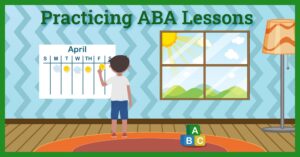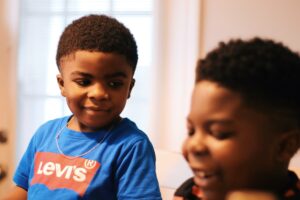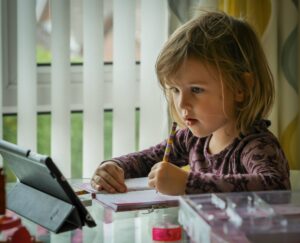
This blog article is part of a series dedicated to Autism Awareness Month. To read the previous article in the series, haga clic aquí!
As parents gain more knowledge and experience with ABA therapy, many begin to realize just how big of an impact they can have on the process. Progress through ABA doesn’t only take place during therapy sessions – by practicing ABA lessons at home, you can help reinforce new skills and concepts your child is learning. In fact, an active and engaged support structure at home is one of the most important elements of effective ABA therapy and to achieving meaningful, long-term results.
Before we dive into specific recommendations about how you can use ABA therapy techniques at home, let’s first cover some of the basics.
Staying Engaged with ABA Therapy
Keeping up with your child’s personalized treatment plan is one of the best ways to bring ABA techniques into your daily routine. Understanding how far along they are in their weekly goals, which skills the ABA therapist is currently targeting, and their overall progress can make it easier to weave helpful activities into a busy schedule. Luckily, most ABA techniques and goals can be transformed into fun games with plenty of opportunities for positive reinforcement.
Asking the Board-Certified Behavior Analyst (BCBA) in charge of your child’s treatment plan lots of questions can keep you informed about how things are progressing. If you’re unsure about why certain concepts or skills are part of your child’s ABA treatment plan, don’t be afraid to request an overview. This information will help you understand how ABA techniques can be applied in real-world environments, including your home.
Another useful way to generate ideas about at-home ABA practice is to observe your child’s therapy sessions and to pay close attention to how the Behavior Technician (BT) communicates. These direct care professionals can provide a wealth of information and recommendations, not to mention what you can pick up by watching them interact with your child. Most BTs are passionate about helping parents get involved in the ABA therapy process, especially when it involves practicing ABA lessons outside of therapy sessions.

Consistent ABA Practice Improves Skill Development
When it comes to helping children diagnosed with autism spectrum disorder (ASD) overcome disruptive behaviors and learn new skills, consistency is key. Most children with autism thrive on routine and repetition, which is one reason ABA therapy is so effective; it’s also why practicing ABA lessons at home can have such a positive impact. For the best, longest-lasting results, you’ll want to make ABA practice at home a core part of your daily routine, not a one-off activity. The more frequent the practice, the higher the chances that the lessons, skills, and behaviors your child is learning through ABA therapy will stick.
Creating a daily routine and a set schedule for practicing ABA skills and behaviors can help get you started on the right foot. As noted by Special Learning, practicing ABA at home does not require special tools – you can simply use objects and toys that are already lying around your house or create your own do-it-yourself (DIY) ABA practice materials. Getting other family members involved is also beneficial, as it can help create a more social, group-oriented environment to practice key ABA skills.
When trying to practice new skills or behaviors, finding a quiet room with little-to-no outside distractions is recommended. Some children with autism struggle with overstimulation, so new lessons won’t be as effective if there are distracting background noises and bright lights. Once your child can apply ABA skills and behaviors in a more controlled environment, the next step is to start branching out. Using the same ABA techniques, try practicing skills and behaviors outside, in quiet public places, and in group settings where other children are present.
After practicing ABA lessons in various settings, your child with autism may start to get the hang of generalization – in short, they’ll start applying the skills and behaviors they’ve learned in regular, everyday environments without any prompting.
Plan For Success, Anticipate Challenges
As every parent of a child with ASD knows, patience is everything. Teaching and supporting children diagnosed with autism takes a lot of energy, positivity, and tolerance. When practicing ABA lessons at home, it’s important to remember that there will be good and bad days, just like in everyday life. There will be times when your child doesn’t want to play along, and that’s okay. Every day is a new adventure, so remember to stay positive and never give up!

Tips For Practicing ABA Lessons at Home
Every child in ABA therapy has an individualized treatment plan based on their needs, so the skills and behaviors you’ll practice at home will vary accordingly. The list below will help get you started with at-home ABA practice, but it’s by no means an exhaustive list of activity options. Chances are the most engaging ABA activities will be your own, so use these tips and tricks to get the ideas flowing!
1. Create Fun ABA Materials
If your child is working on identifying emotions, printing out a poster of emojis can provide you with a useful communication tool. As your child becomes better at identifying the expressions on the emoji faces, you can start asking your child to identify emotions by observing family and friends.
If your child is working on eye contact, doing something silly and funny after the fact will help them associate eye contact with something fun! If your child is working on vocabulary or matching, consider creating flashcards that suit your child’s comprehension level.
To access free ABA practice materials, check out Special Learning’s parent resource page.
2. Utilize Positive Reinforcement
When children are learning new skills through at-home ABA practice, providing consistent praise and positive reinforcement is essential. The learning process can be challenging for children with autism, which is why patience and positivity are so important. Some days will be more difficult than others, and skills that seemed mastered one day (in one setting) might seem forgotten the next.
When your child engages with the ABA practice lessons you create at home, be sure to give them immediate and specific praise, as Autism Parent Magazine recommends. If providing verbal praise, your child needs to know exactly what they did well. For example, if the task involved tying their shoelaces you could say “Good job tying your shoelaces!” or “Your shoelaces look great today!” Over time, your child will slowly start using these daily living skills unprompted and independently.
Of course, verbal praise isn’t the only way to give positive reinforcement. Positive reinforcement can also come in the form of a favorite snack, a cherished game, or playtime with a specific toy. Reinforcements should be individualized to your child’s interests and preferences. If a certain reinforcement does not show positive results, change it up!
3. Have Fun with ABA Arts & Crafts
Arts and crafts are a great way to practice fine motor skills, creativity, independence and a host of other useful skills. Whether your child is painting, drawing, playing with building blocks, or gluing things together, there are a lot of opportunities to practice ABA lessons.
Focusing on arts and crafts that tie in with key ABA lessons is always recommended, as they will help reinforce concepts and skills your child is already learning. For example, painting can be the perfect opportunity to practice color recognition, verbal communication, and following instructions. For ideas about how you can bring ABA techniques into your child’s next art project, check out this fun list of activities from Autism Speaks.

Exploring ABA Lessons and Activities with Applied ABC
Applied ABC offers at-home and in-center ABA therapy for children diagnosed with autism, with a focus on individualized treatment planning and support. Along with our direct ABA therapy services, we also offer parents 100% free training on autism, ABA techniques, and how to practice ABA lessons at home.
To learn more about our ABA therapy services, fill out our Online ABA Assessment or reach out to an Applied ABC team member today!
This blog article is part of a series dedicated to Autism Awareness Month. To read the next article in the series, click here!
Sources:
https://www.special-learning.com/article/bringing-aba-into-your-home/
https://www.special-learning.com/downloadable-resources/
https://www.autismparentingmagazine.com/parents-aba-therapy-home/



